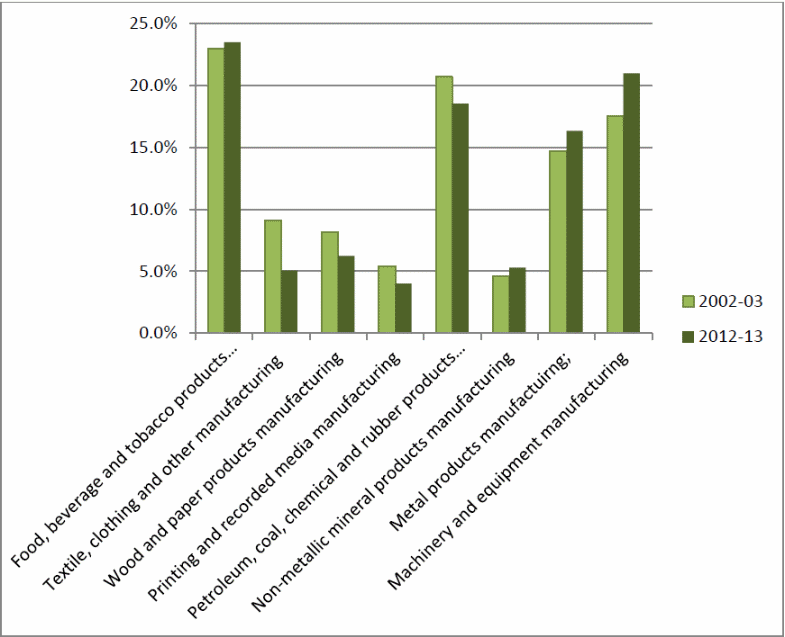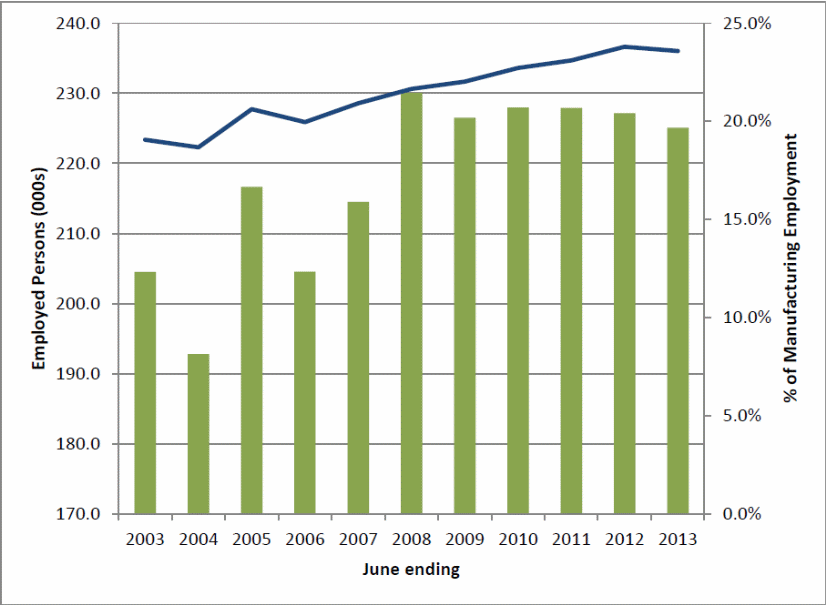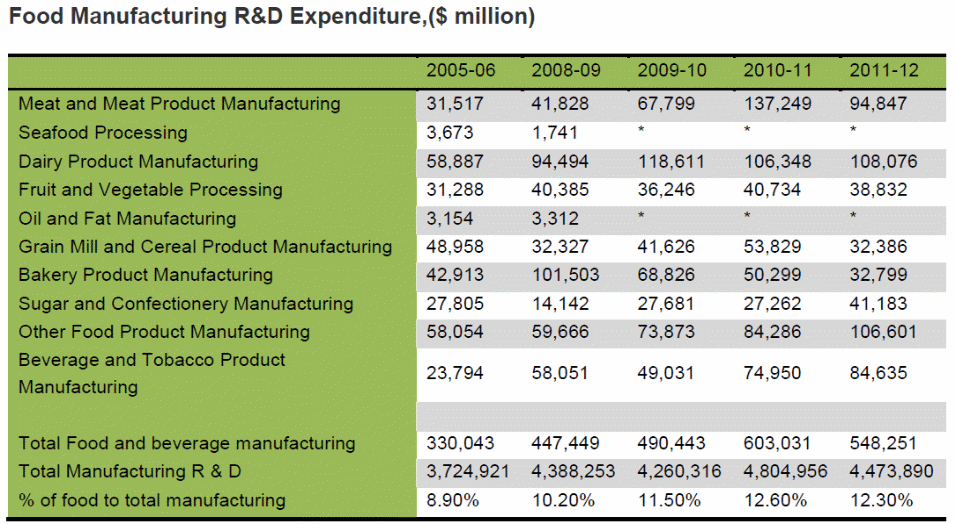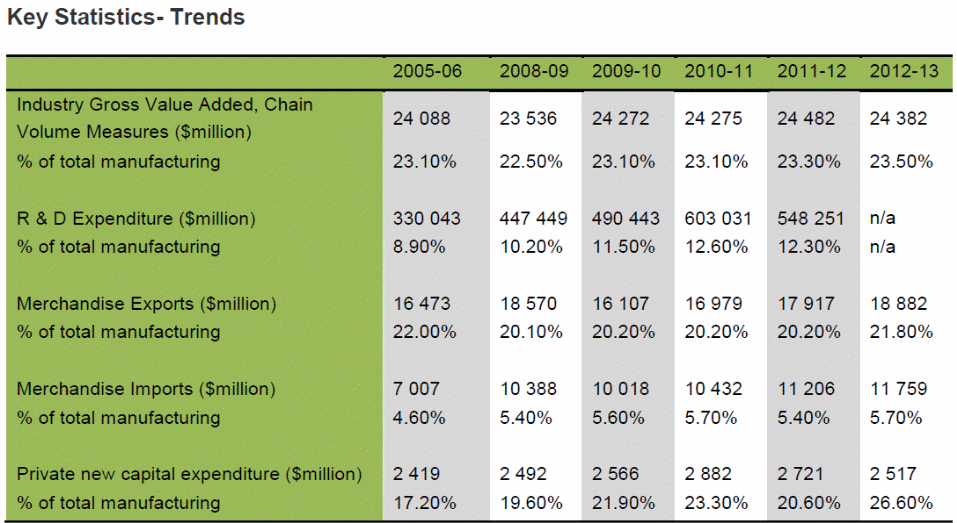Executive Summary
The Australian food processing industry is a vital part of the country’s economy. This paper is a strategic analysis of the industry’s structure. Coupled with a similar analysis of the American food processing industry, this report suggests that Australian food companies should expand into the US market through four strategies – joint ventures, strategic alliances, horizontal investments, and direct exports. These strategies should overcome the institutional challenges of doing business in the US and exploit Australia’s industry resources to create a competitive edge in the global food processing market.
Introduction
The Australian processed food industry contributes to the country’s Gross Domestic Product (GDP). The industry is Australia’s most vibrant manufacturing sector (see appendix one). Similarly, the industry is broad and contributes to the country’s regional economic growth, through employment and new business creation (among other factors).
A 2013 report shows that the country’s food sector employs more than 225,100 people (Australian Department of Industry 2014). This figure represents more than 23% of manufacturing jobs in Australia (see appendix two) (Australian Department of Industry 2014). The biggest food exports from Australia are meat, dairy, wine, sugar, flour, fruits, beer, and oil (in that order).
Japan is the biggest export market for the country’s food products (Australian Department of Industry 2014). Recently, high production costs have limited the competitiveness of the Australian food industry (Julian 2013). This fact has created an urgent need to expand the industry into new markets (cheaper markets).
After exploring and comparing the institutional framework and strategic analysis of the American and Australian food processing industries, this paper proposes that Australian food processing companies should expand into the United States (US). It recommends the joint venture, strategic alliance, horizontal investment, and direct export strategies to do so.
Institutional Framework and Industry Situation Analysis
Australian Food Processing Industry
Institutional Framework
The Food Standard Australia and New Zealand (FSANZ) organisation standardizes food quality in Australia (MPI 2014). Broadly, three government levels control the activities of food-processing firms in Australia – the commonwealth government, state and territory governments, and the local government (DAFF 2013).
The local government is responsible for making sure that food-processing companies comply with food safety standards in their jurisdictions. The state and territory governments cover the activities of food-processing firms, from farm-level production to retail market distribution (DAFF 2013).
At the Commonwealth level, legislators develop government policies on food production, processing, distribution, and inspection (DAFF 2013). Lastly, the Department of Agriculture enforces relevant legislations, at the border, to make sure that all food importers abide by the existing laws (subject to the requirements of the Imported Food Control Act) (DAFF 2013).
Industry Situation Analysis
- Threat of New Entrants. A few industry players (mainly Coles and Woolworths) characterise the Australian processed food industry. The two industry leaders command a 70% market share (Commonwealth of Australia 2014). Both companies have also erected huge barriers to entry in the industry because they control more than 80% of a farmer’s access to the consumer (Commonwealth of Australia 2014). Therefore, the threat of new entrants in the industry is low.
- Threat of Substitute Products. The threat of substitute products in the Australian food industry is “medium” because there is an increased penetration of private-label products in the industry. Similarly, globalisation has increased new product entries in the industry. This development has increased the threat of substitute products in the food industry (Commonwealth of Australia 2014).
- Bargaining Power of Customers. Customer bargaining power in the Australian food processing industry is “medium” because a few companies dominate the market. However, their influence is diminishing because of the entry of new international market players, such as ALDI and Costo (Commonwealth of Australia 2014).
- Bargaining Power of Suppliers. The bargaining power of suppliers in the Australian food processing industry is “low” because globalisation has expanded the scope that food-processing firms can get their raw materials. For example, Coles and Woolworths easily source raw materials from overseas markets, if they cannot get them in Australia, at the desired price (Commonwealth of Australia 2014).
- Intensity of Competitive Rivalry. The Australian food processing industry does not benefit from healthy competition because of its “duopolistic” nature. Therefore, other companies (besides Coles and Woolworths) offer little, or no, competition to established brands (Commonwealth of Australia 2014).
SWOT Analysis
- Strengths. The Australian food industry is experiencing significant growth in its domestic market. The Parliament of Australia (2014) says that from 2003 to 2009, the domestic market for fresh produce grew by more than 40%. The growing markets for food produce support the industry’s growth. Similar to the American food processing market Australia also has high production standards for its food products. This advantage increases its competitiveness in the global food market.
- Weaknesses. The Australian food-processing industry is struggling to stay relevant in today’s market because of increased labour, electricity, and freight costs (appendix three shows increasing R&D costs even with the increased production costs). The high production-related costs affect the sector’s ability to process food locally and export them to other countries. In fact, Genner (2013) paints a bleak outlook of the sector by saying, in 2025; Australia will mainly rely on imported food products (appendix four shows stagnant import and export figures in the last seven years).
- Opportunities. Australian food suppliers need to improve their export capacities to maximise their economic potential. Particularly, they need to know more about their consumers. Although small companies may have trouble in this regard, this action may improve supply chain processes, thereby balancing the power between food processors and retailers.
- Threats. Increased volumes of food imports in Australia threaten the future sustainability of the country’s food market. This threat is new because protectionist policies protected the industry from cheap imports. However, because the industry has to be globally competitive, it has to accept international imports. However, this action threatens the industry’s sustainability.
American Food Processing Industry
Institutional Framework
Many US State and Federal agencies manage the regulatory environment of the country’s food processing industry. However, Federal regulations influence most company regulations in this sector. The United States Department of Agriculture (USDA), Food Safety Inspection Service (FSIS), and the Food and Drug Administration (FDA) mainly manage firm operations in this industry (NDSU 2013).
The FDA has a wider regulatory scope than other agencies because it manages most food processing activities, excluding meat and poultry processing activities (USDA and FSIS mainly serve this purpose) (NDSU 2013). Collectively, these agencies oversee different processes in the food processing industry, including registration, storage, transportation, licensing, inspection, and hazard analysis (among other roles) (NDSU 2013).
Industry Situation Analysis
- Threat of New Entrants. The threat of new entrants in the US food market depends on the barriers of entry for new market participants. Established brands in the US food processing create the biggest barriers to entry for new market entrants through aggressive promotional campaigns and capital concentration. Comprehensively, these factors show that there is a “medium” threat of new entrants.
- Threat of Substitute Products. There is intense rivalry among food processing companies in the American food processing market because different companies offer the same products in the market.
- Bargaining Power of Customers. Customers influence food product prices because they “play” competitors against one another and demand for better quality products, at lower prices. Therefore, consumer bargaining power in the US food processing industry is high because many food-processing companies produce similar products, at low prices (NIU 2005).
- Bargaining Power of Suppliers. Suppliers in the US food processing industry affect the prices and quality of food products. For example, suppliers often increase the prices of raw materials if inflationary pressures increase. American food processing companies always source their raw materials from suppliers who can produce high quality raw materials. Since such suppliers are few, there is a high bargaining power of suppliers in the US food industry.
- Intensity of Competitive Rivalry. American food-processing companies compete fiercely. For example, Coca-Cola and Pepsi have always competed with one another in the beverage market. Similarly, private-label food products compete with established food brands in the market. Therefore, there is a high intensity of competitive rivalry.
SWOT Analysis
- Strengths. Globally, the US food processing industry is more competitive than similar industries in other developed countries. For example, appendix five shows that the US food processing industry has a bigger market than other countries (including Australia). Similarly, compared to other developed markets, the US food processing industry enjoys among the lowest wage rates.
- Weaknesses. Many extensive international, state, and federal laws govern the activities of companies in the American food processing industry. This complex legal environment defines environmental and food safety standards. For example, the FDC Act requires all food-processing companies to avail their products for inspection. The law requires the same companies to abide by other similar rigorous laws. This highly regulated business environment limits the efficiency of such firms.
- Opportunities. The demand for wellness products in America is slowly increasing. Food processing companies can take advantage of this opportunity by producing wellness products that appeal to different groups of customers. For example, young people are looking for low-calorie foods, while older consumers are looking for “health-conscious” diets. If food-processing companies can appeal to these market needs, they would significantly increase the industry’s performance.
- Threats. Unlike the Australian food processing industry, the American market is highly competitive. For example, there is an increase in private label brands produced by giant retail companies, such as Wal-Mart. Similarly, changing consumer habits and preferences create the need for companies to keep innovating to “keep up” with their loyal consumers. Comprehensively, these pressures increase the cost of production for food processing companies, as they have to invest many resources to keep their market shares.
Recommendations
Horizontal Investments
The competitive advantage theory, adopts a comprehensive view of global trade. The theory says many countries trade with one another because they strive to improve their competitive advantages (Fahy 2000). Prevailing economic conditions in America show that the US food processing market has a stronger competitive advantage than the Australian market.
Based on this fact, this paper proposes a horizontal investment strategy for Australian companies to invest in the US market. Developed economies often pursue this strategy because their companies could create enough economies of scale to become efficient (OECD 2014).
Direct Exports
Australia could directly export some of its food products to the US. Through this framework, the comparative advantage theory presupposes that Australia would benefit from this trade in a perfect competitive environment (D’Souza & Peretiatko 2005). When exploring the export strategy, it is important to highlight the role of the 2005 Australia-United States Free Trade Agreement (AUSFTA) (DAFF 2014). This legislation removed all tariff barriers between Australia and the US.
Joint Venture
Based on the highly regulated American food industry, Australian companies could take part in joint ventures with suitable American counterparts because such firms already comply with existing industry regulations. The joint venture strategy would give Australian companies enough resources to do business in the highly competitive US market.
Strategic Alliance
Australian food companies could benefit from a strategic alliance with an American company because it would help them to overcome the biggest challenge in their operations – high production costs (particularly, high labour costs) (Jagersma 2005).
Here, they could exploit the relatively cheaper wages in the US industry by forging strategic alliances with US firms. Many global companies have pursued this strategy through outsourcing some of their production processes to cheaper markets.
References
Australian Department of Industry 2014, Key facts: Australian Food and Beverage products Manufacturing. Web.
Commonwealth of Australia 2014, The Effectiveness of the Competition And Consumer Act 2010. Web.
DAFF 2013, Who is responsible for food safety in Australia. Web.
DAFF 2014, Australia – US FTA. Web.
D’Souza, C & Peretiatko, R 2005, ‘Cultural impact on investment destination choice of US-multinational corporations in Australia’, Cross Cultural Management: An International Journal, vol. 12. no. 3, pp. 14 – 31.
Fahy, J 2000, ‘The resource-based view of the firm: some stumbling-blocks on the road to understanding sustainable competitive advantage’, Journal of European Industrial Training, vol. 24. no. 2, pp. 94 – 104.
Genner, M 2013, Australian food processing to go the way of the auto industry? Web.
Jagersma, P 2005, ‘Cross-border alliances: advice from the executive suite’, Journal of Business Strategy, vol. 26. no. 1, pp. 41 – 50.
Julian, C 2013, Are labour costs killing the Australian food industry. Web.
MPI 2014, Food Standards Australia New Zealand (FSANZ). Web.
NDSU 2013, Regulation of the U.S. Food Processing Sector. Web.
NIU 2005, Comprehensive Industry Analysis. Web.
OECD 2014, Country Statistical Profile: United States 2013. Web.
Parliament of Australia 2014. The Future of the Australian Processed Food Sector. Web.
Appendices
Appendix 1

Appendix 2

Appendix 3
Food Manufacturing R&D Expenditure (Source: Australian Department of Industry, 2014).

Appendix 4
Australian Food Processing Industry Key Statistics (Source: Australian Department of Industry, 2014).

Appendix 5
Comparative Table of US and Australian Food Processing Industries.